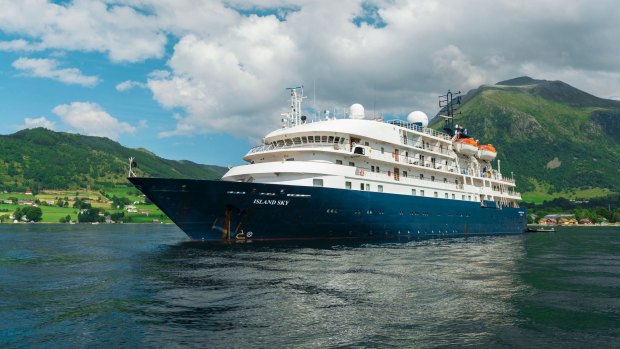This was published 4 years ago
Cruise into Tromso, Norway, where German battleship Tirpitz was sunk during World War II
By Alison Stewart

Scenery, and a sombre slice of history, while cruising Norway.Credit: APT
Sailing out of Tromso, the geographical throat of Norway, lightens the spirit. Here, 350 kilometres north of the Arctic Circle, nature is writ large, the apotheosis of "scenery". Tromso's vivid wooden houses recede; ahead the narrow, orca-rich fiord cuts between marching mountains while above glows an incandescent sky.
You would be forgiven for only gazing outwards, knowing the Lady Aurora dances behind a beguiling curtain of sun, cloud and light, appreciating the Nordic silence that provides its own kind of music.
Look down, however, into the Tromso Fiord and you will find a more sombre slice of Norwegian history. As we sail on APT's MS Island Sky out of Tromso harbour into a peculiarly blue evening light, onboard guest lecturer Kenneth Park tells us that beneath the still waters to starboard, off the island of Hakoya are the remnants of Germany's WWII battleship the Tirpitz, sunk in November 1944 during Germany's occupation of Norway.
The story of the Tirpitz takes its solemn place in not just Norwegian history but in British World War II history. As with any war narrative, the triumphal elements stand beside the grim. The way Britain relentlessly hunted and finally sank her marked a significant British victory, removing a major threat to Allied shipping and ending Germany's naval war in northern waters. But her sinking resulted in the death of up to 1200 people, trapped below decks. A memorial to those lost now stands on Hakoya.
A 2018 German-US-Norwegian study has also uncovered another victim of war – the environment. At Tirpitz's various "hidden" Norwegian berthing locations, the Germans released poisonous chlorosulphuric acid, generating camouflage "fog". A German researcher studying pine tree development in western Norway has found that older trees suffered significant growth damage, affecting them for 30 years.
Tirpitz was the second of two Bismarck-class battleships built for Nazi Germany's Kriegsmarine (navy) during World War II. At more than 50,000 tonnes, she was 2000 tonnes heavier than her sister ship, Bismarck, and was at the time the heaviest battleship built by a European navy.
At 251 metres, with a steel hull 30 centimetres thick, a crew of more than 2600, some of the biggest naval guns ever built, the ability to carry four planes and a 30-knot speed, the Tirpitz was twice as fast as the Norwegian coastal Hurtigruten express vessels, which themselves were faster than any Allied battleship.
Such a monster would be lethal in disrupting Arctic convoys – cargo ships carrying British and American munitions to Murmansk to reinforce the Soviet Union front, aiding the Allied effort. And apart from stopping the cargo, Hitler also wanted the Tirpitz deployed strategically, to keep the Allies busy and prevent an attack on occupied Norway. British prime minister Winston Churchill initiated a series of operations to eliminate the three-year-long thorn in the Allies' side.
The Tirpitz had sailed to Norway in 1942, initially mooring in the Trondheim Fjord, where British aircraft unsuccessfully attacked her. The Germans moved her north of Trondheim and then to remote Kafjord in Alta, their largest naval base outside Germany and a long way by air from Britain.
The approach to the Kafjord was easily defended so in September 1943, the British initiated Operation Source. They deployed midget submarines that slipped the anti-sub netting and planted explosives, which cut an 18-metre gash in Tirpitz's side. She wasn't disabled, however, and repairs were completed in April 1944. The Allies bombed her six more times in the following months.
Tirpitz was moved to Hakoya Island near Tromso in October 1944. In November, in a final mission codenamed Operation Catechism, a squadron of 32 British Lancaster bombers carrying Tallboy bombs designed to penetrate Tirpitz's steel hull, flew across Sweden to Tromso.
RAF wing commander JB "Willy" Tait saw Tirpitz "lying squat and black among her torpedo nets like a spider in her net, silhouetted against the glittering blue and green waters of the fiord". Tirpitz was hit three times and capsized in 11 minutes.
The great battleship lay in shallow waters, her hull in the air until she was broken up between 1948 and 1957 in a joint Norwegian-German salvage operation. The story of the Tirpitz is told in a museum in Alta's Kafjord and in the Tromso War Museum housed in a World War II bunker.
Knowledge of such destruction sits in stark contrast to our happier circumstances – anticipating our dinner of white asparagus soup and cuttlefish with lemon butter on Island Sky's Lido deck as the sun, like a naughty child at bedtime, lingers in the sky.
FLY
Qatar Airways flies daily from Sydney and Melbourne to Stockholm or Oslo via Doha, then Tromso with Scandinavian Airlines. See qatarairways.com; flysas.com/au-en/
CRUISE
APT's 15-day Majestic Norwegian Fjords small ships expedition cruise from Tromso to Copenhagen starts from $17,495 a person, twin share with an air credit saving of $1200 a couple, based on a June 18, 2020 departure. See aptouring.com.au
Alison Stewart was a guest of APT.
Sign up for the Traveller Deals newsletter
Get exclusive travel deals delivered straight to your inbox. Sign up now.